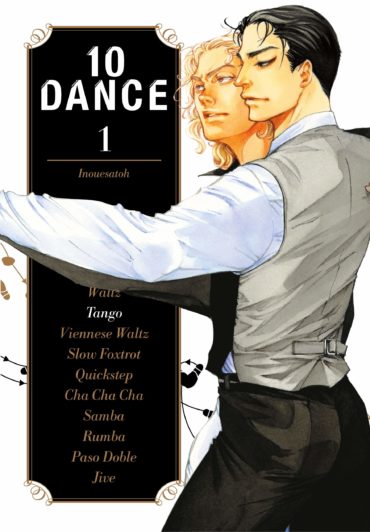10 Dance Volume 1 Review
‘There are five competition dances in the Standard: the waltz, the tango, the Viennese waltz, the foxtrot and the quickstep. My speciality is the other type, Latin. We also have five dances we compete with: the cha-cha-cha, the samba, the rumba, the paso doble and the jive.’ Shinya Suzuki
One man is an international champion in Standard Ballroom, the other is the national champion in Latin Dance. Chalk and cheese in temperament, suave Shinya Sugiki (traditional ballroom) and fiery Shinya Suzuki (Latin American) have been observing each other’s stellar progress from a distance – until the desire to compete in the challenging 10-Dance Competition (‘a glittering Triathlon’) brings them together. Can Sugiki teach the free spirit Suzuki how to excel in the formal discipline of the waltz – and can Sugiki teach the supremely self-controlled Suzuki how to let his hair down and respond to the earthy, raunchy rhythms of the samba and the rumba?
The two champions agree to meet late at night to train together, bringing their dancing partners along: Fusako Yagami and Aki Tajima. But whereas the two women seem to understand each other and make good progress, sparks fly from the start between the two Shinyas. They’re both so different; only their stubborn natures stops them from giving up when it seems that they’re making no progress at all. Sugiki has trained in England since he was five (‘It all started in Blackpool, a country town in England’) whereas Suzuki, who is half-Cuban, was a Cuban citizen until the age of twenty. It looks as if two such different and charismatic temperaments will never be able to learn from each other and the 10 Dance plan is doomed from the start. Or…is it?
As Kodansha Comics have had such a success with Welcome to the Ballroom by Tomo Takeuchi, it makes sense that 10 Dance would make a great addition to their list. However, apart from the fact that both are manga about competitive ballroom dance, they have little else in common. Welcome is a shonen title, with young high schooler Tatara starting out as a dancer as its main focus, whereas 10 Dance began life as a Boys’ Love one-shot (2003) and concentrates on the relationship between its two adult protagonists at the height of their careers with the art they love and the undeniable attraction they begin to feel toward each other. The one-shot is included as a special chapter ‘Samba de Men’s Love’ and is set before Chapter 7 (which is in Volume 2). (Another earthier BL title The Man of Tango by Tetuzoh Okadaya from SuBLime is Mature-rated and has some fascinating insights into the world of Latin dance and its performers but takes a very different approach.)
Inouesatoh’s wonderfully fluid and expressive graphic style is ideally suited to a manga about dancers. She uses a wide variety of panel sizes to convey the dancers in motion, creating some truly breathtaking images. And she’s also very good at capturing the fleeting yet telling changes of facial expressions that tell the reader more than just the words being spoken. Match the distinctive art to a strong story, a mischievous sense of humour and sizzling character interactions and this manga is off to a really strong start. Even though Inouesatoh is good at conveying the magic of ballroom dancing (sparkles and sequins!) she also reveals the blood, sweat and tears that the dancers put themselves through behind the scenes to make it all look so effortless on the dance floor. The characters are brought to vivid life through the dialogue as well as the pictures; as Sugiki and Suzuki constantly clash in the dance studio, their interchanges fairly crackle (helped by the excellent translation by Karhys).
This large-format edition by Kodansha Comics is a good showcase for Inouesatoh’s art and four striking colour pages are a real bonus (admittedly the last is one of her not-so-serious images; the two men’s expressions are absolutely priceless!)
As music is vital to any story about dance, Inouesatoh uses song titles as chapter headings (a little freely) ‘Some Day my King Will Come’, ‘Moliendo Cafe is a Samba’ and ‘Estrellita’ and in the Afterword, she explains a little about the inspiration behind these choices. There’s also the usual excellent Translator’s Notes to help shed light on some dance-related terms in the text and the significance of honorifics in certain contexts.
10 Dance is a must-read for anyone who’s enjoyed manga and anime about competitive dance (on or off the ice!) and the lives of the artists who devote themselves to being the very best.
Find out more about 10 Dance at Kodansha Comics here


